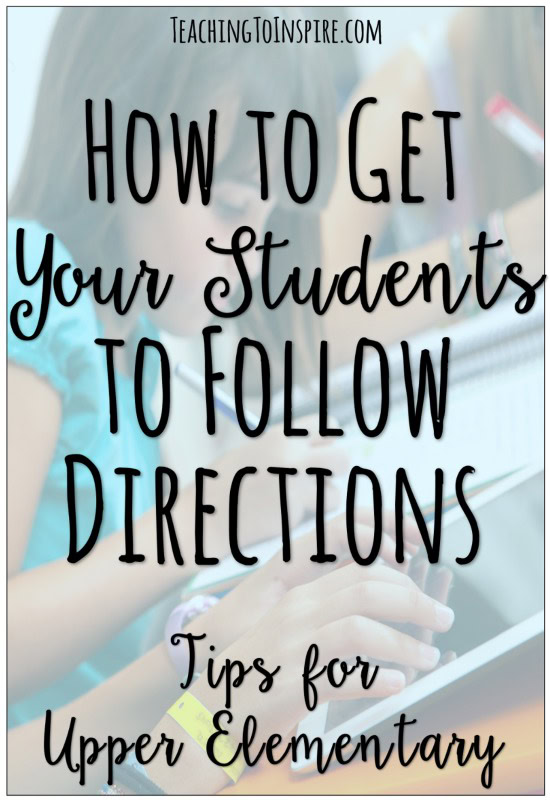Getting students to quickly follow directions is a work of art for sure. My first couple of years teaching, I am not sure how much of my instruction time I wasted repeating directions, clarifying unclear directions, redirecting students who were not following directions, you get the idea!
The next couple of years, I experimented with strategies and techniques to get my students following directions quickly, quietly, and correctly. I wanted them to be held accountable for following directions, while still promoting a positive learning environment. This post will share all those tips with examples from my own classroom.

Following Verbal Directions
Choral Repeat Directions
When you give quick one to five words directions, have your students choral repeat the directions after you give them and before you expect them to complete the directions. I do this regularly when telling the students which page to turn to of a common novel or textbook. For example: I will say “Turn to page 64 in your science textbook. What page?” and the students will immediately respond with “64” as they are turning to that page. This ensures the students know exactly what page to turn to and any students who have gotten distracted are immediately brought back when they hear the other students choral repeat or respond.
Repeat Directions with Partner
For lengthier directions or multi-step directions, I often have my students quickly repeat the directions with a partner. The key is to do this quickly because you don’t want this to take up your instructional time; you want this to actually enhance it by making sure the students are all on the same page. I listen in while they are repeating the directions and if I feel there is confusion with some of the students, I will address those before the students continue with the task.
Use Countdowns or Timers
Speaking of making sure that the strategies you use enhance your instruction time instead of taking away from it, I regularly use a countdown (verbal or online). I also give my students a specific time limit to complete routine everyday tasks. For example, the students will have maybe 10 seconds to put up math materials and transition to science by taking out their science materials. For tasks that take longer, I will set a timer on the smartboard and then hold the students to that time.
Physical Response when Finished
As much as possible, I try to use physical responses or silly responses when my students are finished with a quick verbal direction. An example of this is actually one of my favorite go-to strategies that I think has the biggest impact on my students following directions quickly (and quietly). When I give my students a direction (take out your reading book, write your name on your paper, etc), they know to indicate they are done by putting their thumbs up. This keeps the sense of urgency as they know they need to get it done and get their thumbs up to let me know they are ready. This also communicates the expectation that they will “show me they are ready and not tell me by talking.”
Another strategy I use for multi-step directions is having the students hold up the number of fingers that represent the number of things I need them to do. For example, “When you return to your seat, take out the book you are reading (1 thing – 1 finger), find the page you are currently on (2 fingers), and write a summary of what you have read so far (3 fingers). The act of going through the directions and holding up the fingers really helps the students remember all of the tasks you have asked them to do.
Use Similar Procedures and Routines as Much as Possible.
Using procedures and routines to keep as much as possible consistent will take away the need to even give directions for the students to follow in many cases. For example, in my classroom, students know that when math is finished, they are to take out their social studies interactive notebook, reading text, and show me they are ready for social studies with a thumb up. I don’t even have to give this direction by the second month of school. They know to do it and do it quickly.
Another example is when we come back from lunch, the students know to take out their language notebooks, find their language review, and begin that day’s review. If it is the first day of the week, they know to turn to the next clean page in their language notebook and wait for instructions. I always spend the first month or two of school teaching and reviewing these procedures and that work pays off.
Use Positive Reinforcement or (Friendly) Competition.
Use positive reinforcement or competition with teams or groups when you are giving directions that you want followed quickly. Groups that follow directions quickly can gain points or just receive a compliment. I always try to go positive when I am reminding my students to follow directions. I have found that, for the most part, this naturally makes the other students want to follow directions.
Include Written Directions to Accompany Verbal Directions.
Multi-step directions or directions that span over the course of more than 30 minutes are always written on the board in short phrases and numbered in the order they need to be complted. When the students are not following directions or if they ask what to do next, I can easily remind them to look at the board.
Now, I know what you are thinking. These tips are great for verbal directions, but my students can’t seem to read and follow written directions on their assignments. I have some tips in that area, too!
Following Written Directions
Close Read Directions
One strategy that really made a difference was explicitly teaching my students how to “close read” every direction on an assignment. For the first couple of months of school, we did this regularly as a class until it became habit. We would read the directions, circle or underline the important information in the directions, and then retell the directions in our words.
Silent Read, then Discuss with Partners
Another tip is to have the students silently read the directions first (this helps hold each student accountable) and then have them quickly restate the directions to a partner before beginning. Again, this strategy is something I implement consistently at the beginning of the year and then pull away once I see that the students have internalized the habit of reading the directions first. If I see that my students are slipping on reading and following written directions, I will bring this strategy back as a class or the close read strategy shared above.
Teach the Students to Number the Tasks in a Set of Directions
Another helpful strategy for written directions is having the students number the tasks in the directions. They do this by simply placing a number above that phrase or sentence in the directions. For example, the following written direction has four different tasks and the students would simply place a number above each one:
Read each sentence and underline the example of figurative language. Then determine which type of figurative language is being used and explain the meaning of that phrase.
With some classes, I have even taken this strategy a step further and required them to check off the number after they complete each task. This not only ensures they understand the directions but also holds them accountable for following those directions.
Implement a Procedure for When Students are “Stuck” and Need Help.
Even with doing all of these strategies, you will have times when students are not sure they are following directions correctly. Have a clear procedure in place for the students to ask for help. I like to use the Ask 3 Before Me strategy. Using this strategy, the students have to ask three students for help on an assignment before they can ask the teacher. This allows them to get the help they need, while also holding them accountable for asking for it from peers.
Another option for lengthier independent tasks is to have a “parking space” in your room where the students write a question on a sticky note and place it on an area of the markerboard or a chart paper. This is a common strategy used in professional development, but it can also work in classrooms. You can have a student in charge of checking the parking space and helping to answer the questions.
Teach Students How to Ask for Clarification
Even though I set the expectation that my students need to listen to understand the directions, there are times when students are genuinely confused by what you want them to do. I still want my students to feel comfortable asking for help or clarification. We spend time at the beginning discussing how they can ask for help or clarification instead of saying “I don’t know what to do” or “What am I supposed to do?” We make an anchor chart together and I leave it hanging all year and refer to it as needed.
Here are some examples statements we may put on our chart:
- I understand _____ but I am confused about _______________.
- When you said __________________, did you mean ___________________?
- Can you show me an example so I can make sure I understand correctly?
By doing this, you are holding your students accountable for listening to the directions, but you are also teaching them that it is okay to ask for clarification. This promotes an environment where the students take accountability and feel safe asking questions.
Do you use any of these tips or strategies? What do you personally do to ensure your students follow directions? Let me know in the comments!







What wonderful tips!! Thanks so much for sharing 🙂
You’re welcome!
I use music as a cue at the beginning of my Language Arts class. As students enter I have a list of tasks they need to complete or materials they need to get. Then I play a 3 minute song (I like to use Mission Impossible). The students know I start teaching as soon as the music finishes.
I love that idea, Danielle! Kids always love music and they would love that! Thanks for sharing!
That’s a great idea! I also like that they know as soon as the music stops, it’s time for you to start teaching. I’m sure that helps your class time run more smoothly!
Excellent tips! I’m going to try a lot of these. Thanks!
You’re welcome! I would love to know how they go after you try them out.